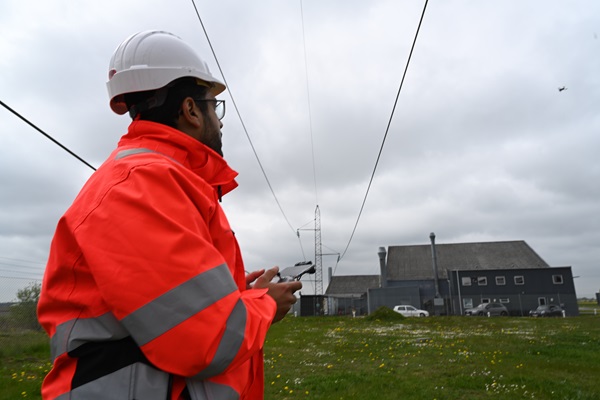
Self-flying Inspection Drones Can Save Lives and Billions of Euros. And Soon, They Can Become Reality
In just five years, it may be autonomous, self-charging drones that monitor cracks in bridges, worn out railways, and other inspection tasks on critical infrastructure. The potential is enormous, say the researchers behind the European Drones4Safety project, which has just concluded
Five years.
If you ask the researchers behind the just-completed Drones4Safety project when they estimate that autonomous swarms of drones capable of inspecting infrastructure and recharging their batteries directly from high-voltage lines will be reality, this is their answer.
The drones can replace the current manual inspection, which is both expensive and cumbersome, and perhaps as early as 2028.
"I believe that we can have the first commercial drones capable of self-recharging on high-voltage lines ready in three, maybe four years," says Emad Samuel Malki Ebeid, Professor at the University of Southern Denmark and the research leader.
”This will be the steppingstone towards the creation of various applications in which the drones operate autonomously and deliver data remotely to the infrastructure operators. Building such software services may take a year”
Preventing accidents and saving money
Drones4Safety took flight in 2020 with a grant from the European Commission under the Horizon 2020 programme, a budget of 3,5 million euros, and a consortium consisting of a total of nine partners. One of the triggering reasons for the project was the tragic accident in Genoa, Italy, in 2018, where a bridge suddenly collapsed, killing 48 people, sparking a debate about the state of European infrastructure.
The goal of the project has been to develop drones that can fly autonomously and, with the help of a camera and an AI software system, inspect infrastructure bridges and railways and detect any faults and deficiencies.
When the drones are running out of power, they can, with the help of an onboard navigation system, find and securely grasp onto a nearby high-voltage line to recharge, after which they can return to their task. The idea has also been that the drones should fly in large swarms to inspect infrastructure faster and more efficiently.
"With autonomous drones, we can do inspection work better, cheaper, and more frequently," as Professor Emad Samuel Malki Ebeid says.
This will not only mean that we can avoid future accidents because the infrastructure is maintained more regularly, and faults are detected earlier. It will also save us the enormous sums currently being spent on slow visual inspections with, among other things, cranes and helicopters.
The researchers estimate that inspection costs could be reduced by 90%, and in Europe, it could save 15 billion euros annually.

Revolutionizing the entire drone sector
Over the past three years, the researchers have demonstrated that inspection drones are both technologically feasible and economically profitable.
"We have developed a business plan for the drones, and what we can see is that it is not only technically possible but also financially profitable.
It looks very promising," says Paolo Guzzini, Senior Product and Quality Manager at the French drone company Delair and one of the project partners.
Gerd vom Bögel from Fraunhofer, Europe's largest institution for applied research and yet another project partner, agrees:
"With the project, we have shown that the innovative idea of autonomous inspection drones is not just fiction. It is actually possible."
It was especially noteworthy when the Drones4Safety team in 2022 successfully landed a drone on a high-voltage line and recharged the batteries for the first time ever.
"It's a general problem for all drones that they have limited battery capacity. Typically, they cannot fly for more than 10-15 minutes at a time before they need to land and change the battery," says Emad Samuel Malki Ebeid.
Therefore, the professor does not hesitate to call their charging module with the onboard navigation system, weighing only 500 grams, a potential revolution for the entire drone sector.
"It could also be used in many other areas where drone's short flight times are currently limiting. For example, agriculture, rescue work, and traffic surveillance."
Legislation is a barrier
However, there are still challenges standing in the way of widespread adoption of the technology.
In particular, legislation needs to change. As it stands, it is not legal to fly close to infrastructure, let alone without an operator manually controlling the drone with visual contact.
"Fortunately, this is something that is being worked on and discussed in various places right now, in part because of the work we have done in Drones4Safety," says Gerd vom Bögel from Fraunhofer.
The team behind the research project also still needs to involve more infrastructure companies in the project, and they are currently working on securing funding for phase two of Drones4Safety, where the drones can be further tested in the industry.
"But before we can do that, it requires innovative companies that can see the potential of the technology," says Paolo Guzzini.
And, of course, there are also many technical details that need to be worked out before it becomes commonplace to see self-flying and self-charging inspection drones flying around. Among other things, the drones need to be more stable under different weather conditions.
"You could perhaps put it this way: now we've learned how to cook the dish," says Professor Emad Samuel Malki Ebeid from the University of Southern Denmark.
"Now we also need to learn how to make it delicious."